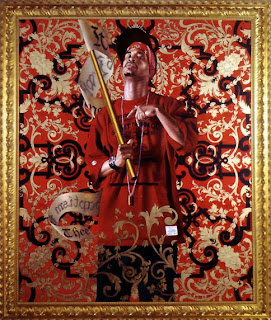"The concept of intertextuality reminds us that each text exists in relation to others." (Daniel Chandler, 2003)
As quoted above by Chandler, the idea of intertextuality is about how different texts are influenced and referenced insight of others. It is about the shaping of texts' meanings by other existing texts. Everything that has become in the text was drawn and sourced from previous material read by the reader.
2. Research Wiley's work and write a paragraph that analyzes how we might make sense of his work. Identify intertextuality in Wiley's work.
'Untitled' (2009)
'Napoleon Leading the Army over the Alps'' (2005)
3. Wiley's work relates to next weeks Postmodern theme "PLURALISM" . Read page 51 and discuss how the work relates to this theme.
The postmodernist idea 'Pluralism' relates directly to most, if not all of Wiley's works. Wiley depicts African men with urban attributes such as street clothing etc, and places them in environments where you would usually expect a middle class white man to be depicted. You would expect this because in the past it has only been acceptable to paint white middle class people in the prioritizing places. Nowadays people are moving away from that absurd point of view and are including more varieties of cultural groups, less focus is on single ones.
''Count Potocki'' 2008
4. Comment on how Wiley's work raises questions around social/cultural hierarchies , colonization, globalisation, stereotypes and the politics which govern a western worldview.
As Wiley grew from painting from photographic portraits of people from his city, his style started to question colonization and politics. Replacing what would usually be a middle class white person, with an African man, he has outlined and described previous problems that are amongst society. He is showing that the different social/cultural hierarchies within our races are all as important as each. I think he has done well to depicted the fact the black people have gained more acceptance into todays society, and that they should no longer be seen as anything less that any other culture.
5. Add some reflective comments of your own, which may add more information that
you have read during your research.
I think that Wiley's work do a lot for our society in more than one way. His strong beliefs and thoughts are shown well with his referencing, media choices, and his contemporary style. Being someone from a country where racism and exploitation has always been a big issue, his work is very inspiring and paints interesting, deep thoughts in the viewers mind.
en.wikipedia.org/wiki/Kehinde_Wiley
www.artnet.com/awc/kehinde-wiley
www.thinkcontra.com/kehinde-wiley-on-current
www.robertsandtilton.com/artists/wiley
ALVC Handbook



No comments:
Post a Comment